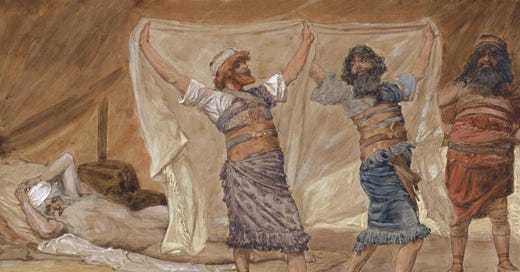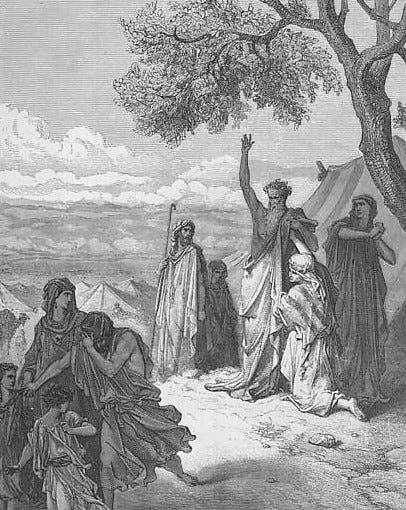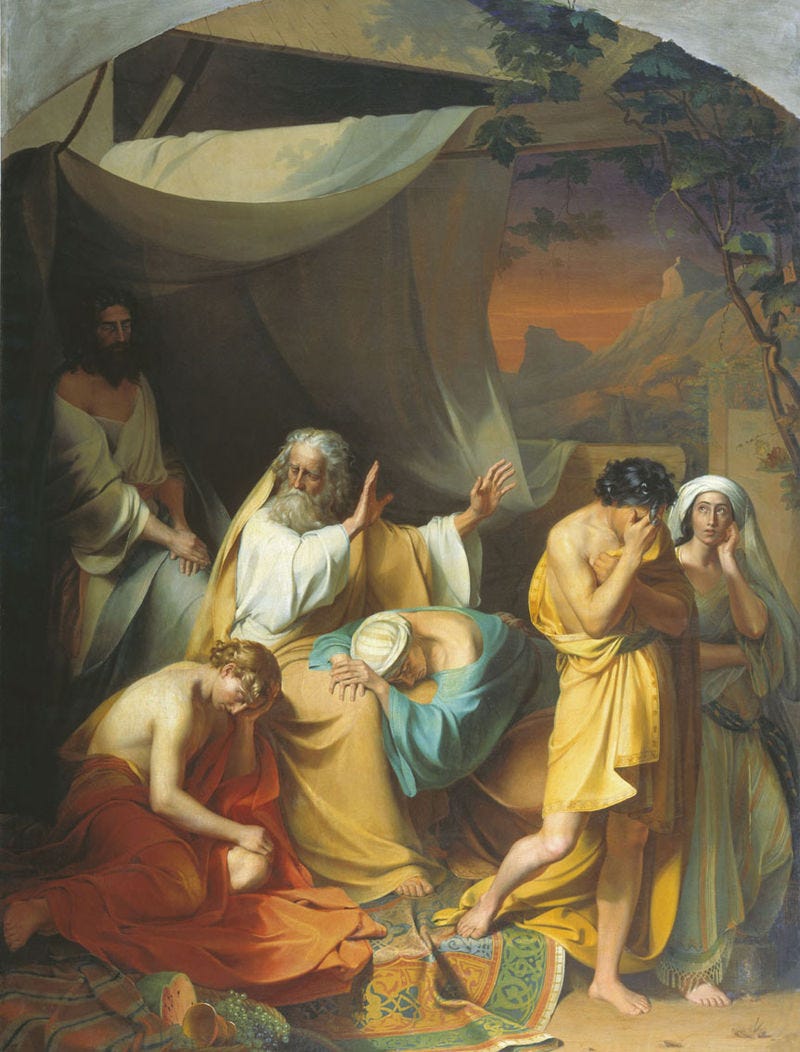The Curse of Ham: Noah’s Corrupted Child
"Cursed be Canaan; he Shall be a Slave Among Slaves to his Brethren." -Genesis 9:25
Before diving into Cush we should deal with the main story relating to Ham, or “Cham” as he is known in Hebrew sources. The well known “Curse of Ham” resulting from some sort of encounter between Ham and Noah is often misunderstood as a “Curse UPON Ham”, but this is not the original meaning, nor indication. Instead, the curse is upon Canaan, the descendant of Ham, who will serve his brothers, and a more appropriate terminology would be “Curse of Canaan”.
Some of the language employed in the text indicates Canaan being the son of Ham, while also a “brethren” to Shem and Japheth; mentioned alongside the brother’s blessings from God might indicate Canaan was the result of some form of impropriety between Ham and Noah begetting Canaan’s inclusion in the trio’s story unlike any other children. Turning to the Gemara (Sanhedrin 70a) we find a discussion between Rav and Shmuel concerning the actual act of Ham. Rav and Shmuel interestingly disagree; one says “castrated” while the other says “sodomized”.
Concerning castration, the claim is made that since Ham injured Noah with respect to the possibility of conceiving a fourth son, therefore Noah placed a curse upon Ham’s fourth son, Canaan. It is important to reinforce that it is Canaan, and not the other three sons of Ham who have the curse placed upon them, signifying some importance to the birth order, or Canaan’s involvement in the events.
Regarding those who say that Ham “sodomized” Noah learned this from an analogy between the word “and he saw” and “and he saw”. Explaining this further, it is written “And Ham, the father of Canaan, saw the nakedness of his father” juxtaposed with the line “And Shechem, son of Hamor saw her and took her and lay with her and afflicted her” (Genesis 34:2) indicates that the term “and he saw” is used as a metaphor for forced sexual intercourse.
This second answer has an issue, one that the Gemara quickly addresses, with regards to the lack of any indication why this second explanation would imply the curse is upon Canaan, rather than on Ham directly. The Gemara reconciles this by saying “All agree Ham castrated Noah”, and that “some say also Ham sodomized him” in addition to the castration.
What we can say is that “castration”, however this term is applied or translated, occurred between Ham and Noah. We can also say that “sodomy” of some sort might have been involved in addition to the castration. If I were to posit a theory, this relationship between Ham and Noah might not have been the “physical act of castration” but rather a spiritual act of castration and technical limitation of Noah having a fourth son. I would never posit a theory Chazal (sages) have not already posited, but there is the possibility that Ham’s relationship was not between him and Noah, but rather Noah’s wife, thus Ham’s mother, to the point where she could no longer have children with Noah. This would have been an effective castration for Noah’s ability to have children since she was the only woman still alive following the flood available for Noah to marry.
Addressing the possibility of an additional sodomization of Noah and how this could play with our theory of a potential rape of Noah’s wife, the sodomy could have been a generalized terminology for a forbidden relationship, or forbidden sexual act. There is no reason to believe this same “act of sodomy” couldn’t have occurred between Ham and Noah’s wife, and may have also resulted in effective castration. Furthermore, the actual order of this story in the Torah places it after the story of Noah planting a vineyard and becoming drunk, tying it directly to the resulting actions of Ham. Alcohol and Sexual impropriety go hand and hand to this day. This “rape of Ham’s mother” would potentially square away with both understandings, and incorporate them jointly.
Turning to another textual source, we should look at Midrash Tanchuma 13:4 where it goes on a lengthy diatribe regarding a relationship between Noah and Satan, not dissimilar from the relationship between Adam and Satan. It states that Satan sort of convinces, and shows Noah the darker side of drinking, even going so far as to stating there was a pig and ape slaughtered on the site of the vineyard as a blood sacrifice to fertilize the soil. The Midrash assigns deep meaning to these animals and extols the benefits of avoiding intoxication, but ultimately states that all of the negative actions possible under the influence happened to the righteous Noah.
It follows this in Tanchuma 13:5 where it addresses the Curse of Canaan directly with an extremely lengthy discussion of evil inclination and how it leads to slavery, implying a relationship between losing one's self-control/consciousness to the point they are a slave to desire and impropriety. Tanchuma 13 is interrupted by Tanchuma 14 which goes on to again discuss Abraham and a sort of avoidance of evil inclination. It returns once again in Tanchuma 15 where it discusses Noah’s planting a vineyard, and how Shem and Japheth covered Noah possibly with a Tallit, begetting the mitzvah to wear blue tassels on our garments. Some sources claim that Japheth received a “cloak fastened with buckles as a sign of importance” a clear metaphor for Kingly garments and robes. The indication here is thus that Japheth fills the Kingly role, and Shem fills the priestly role harkening back to the Torah where it says “Ham will be their servant”.
Continuing further in Tanchuma 15:2 it claims R. Judah said “a curse cannot prevail where a blessing had already occurred” implying that Canaan must have been born while they were on the ark. This is not to say the events did not occur after the ark, but merely that the blessings of protection afforded to Ham’s other children did not apply to Canaan, thus meaning he was sort of the “odd one out” and ended up receiving the curse. Not to discount R. Judah, but this explanation on its own is not enough to explain why Canaan would have been cursed for his fathers acts, but does help single out a key difference between Canaan and his other brothers.
Tanchuma further claims that R. Nehemiah held that Canaan was actually the one who had uncovered Noah’s nakedness and had therefore informed his father, Ham, concerning the events. This therefore places Canaan at the center of the events that unfolded, and places the entire blame of the sin not upon Ham, but upon Canaan hence the actual line says “Curse of Canaan” and not Curse of Ham.
Going even further down this rabbit hole in Tanchuma 15:3 we find that our sages state that while Noah was in the ark he said to himself “Would that my sons possessed slaves so that they might remain seated while being served. When I depart from this place, I shall produce a descendant who will be their slave.” Following this, Noah approaches Ham, saying to him that he prevented him from begetting a fourth child who could serve the other three brothers, therefore Ham must now produce a fourth son that would become a slave in his place. Tanchuma states that this is the view of those who believe Ham castrated Noah.
In effect, this opinion further reinforces the possibility that Ham actually prevented Noah and his wife from having children in some capacity, but still doesn’t really explain why Canaan himself had to be cursed beyond the possibility that Canaan was born on the arc (the other three sons of Ham being born prior) thus preventing him from the blessing of protection. Again returning to the possibility of this all actually occurring between Ham and his mother, Noah’s wife, then there is the chance Canaan was actually born of this forbidden relationship. The entire biblical passage is very strange, and easily one of the most mysterious passages in the Torah given its early placement in the events of humanity. For me to attempt to fully understand it would be impossible, but I would leave open the potential that if Canaan was the son of Ham and his own mother, it would explain the curse being placed directly upon Canaan, while also explaining a potential occurrence of sodomy and guaranteed occurrence of castration, or prevention of having children again. Additionally, this would round out our previous theory regarding Canaan’s inclusion in Genesis 9:18 among Noah’s children who leave the ark in order of spiritual purity.
While a full analysis for this event should be left to a rabbinic discussion, for our purposes we need to understand this event doesn’t curse all of Ham’s descendants, and is meant as a denunciation of Israel’s rivals, the Canaanites. Later on this curse becomes quite important for the justification of the Israelite conquest of Canaan, but in a geographic sense doesn’t give us any information other than centralize Canaan/Israel as a disputed territory between the brothers.
We have concluded our introduction on Ham, and set the stage for a full analysis of his children. Next week we will begin Cush. Please like, comment, and share the post if you got some value. Thank you for reading, and I hope you understood some more wisdom.








